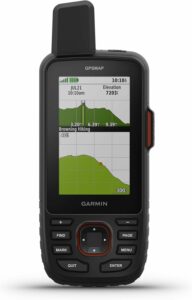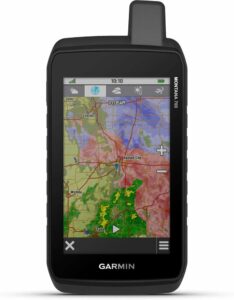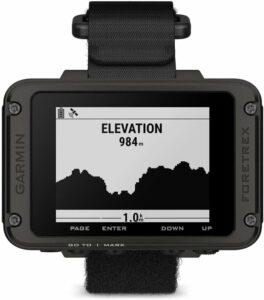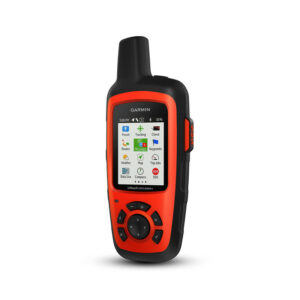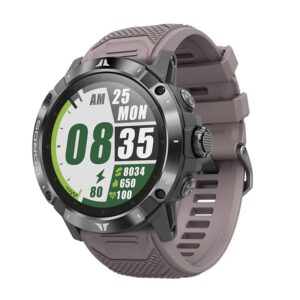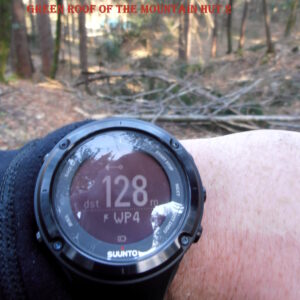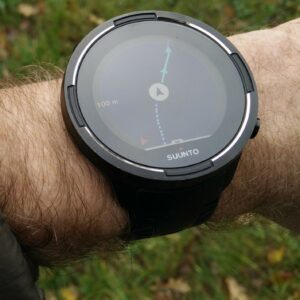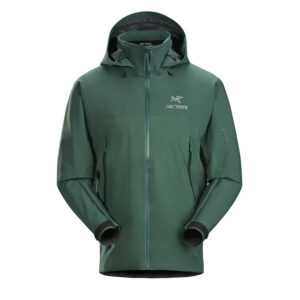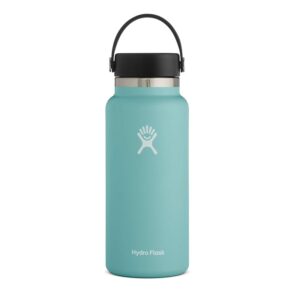When you are hiking far away from the civilization you need reliable navigation. Smartphones are fantastic for day hikes and casual back‑country excursions, yet their batteries drain fast, screens can crack easily, and they often struggle to get a GPS fix in forests and narrow valleys. GPS watches are gaining popularity and are undoubtedly useful for navigation. Nevertheless, we prefer handheld GPS devices for their battery life, ease of use and in most cases superior maps. Many handheld GPS devices show detailed maps and in some cases, even satellite imagery. In contrast, most GPS watches can only display your location and direction concerning waypoints and routes (breadcrumb trail). The ability to easily insert new waypoints and plan routes directly on the device is another plus of handheld GPS devices. To achieve this on a GPS watch, you’d typically need a computer or a smartphone with a working internet connection.
Here we have selected the five best handheld GPS devices for 2025. Each unit offers rugged construction, multi‑GNSS support for faster fixes, outstanding battery life, and some even advanced safety features like SOS messaging. Use this guide to pick the right device for your next adventure – but remember that no GPS replaces basic navigation skills. You should never do a trail you don’t know without a map and compass.
Updated Content
We regularly update our reviews and selections to always recommend you the best products on the market.
Expert Selections
We only list top-tier products. Read how our selections of best hiking products differ from others here.
Links
We use affiliate links and may receive a small commission on purchases at no extra cost to you.
1. Our Hiking GPS Picks
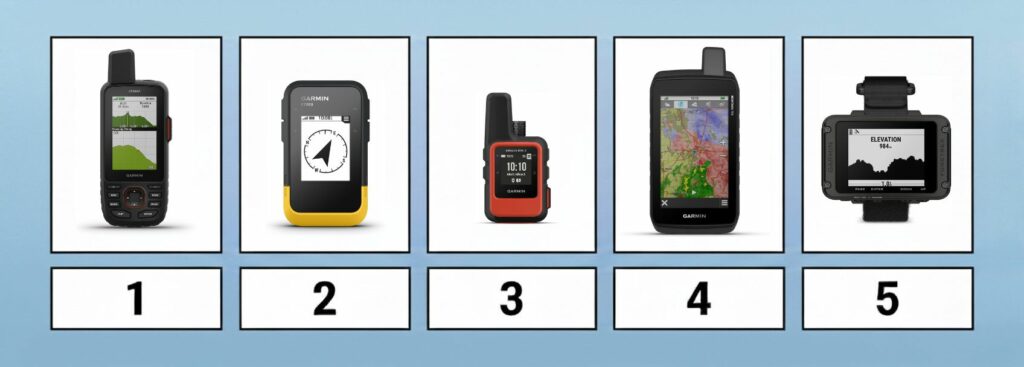
The Best Hiking GPS
- Garmin GPSMAP 67i – Best overall GPS for hiking
- Garmin eTrex SE – Best budget hand-held GPS
- Garmin inReach Mini 2 – Best ultra‑light GPS and satellite messenger
- Garmin Montana 700 – Best touchscreen GPS
- Garmin Foretrex 801 – Best hands‑free GPS
2. Comparison of Hiking GPS Devices
| Feature/Product | Garmin GPSMAP 67i | Garmin eTrex SE | Garmin inReach Mini 2 | Garmin Montana 700 | Garmin Foretrex 801 |
|---|---|---|---|---|---|
| Weight | 8.11 oz. | 5.5 oz. | 3.5 oz. | 14.5 oz. | 3.8 oz. |
| Weight (Metric) | 230 g | 155 g | 100 g | 410 g | 108 g |
| Size | 2.5 x 6.4 x 1.4 in. | 2.4 x 4.0 x 1.3 in. | 2.04 x 3.9 x 1.03 in. | 3.4 x 7.2 x 1.3 in. | 2.9 x 1.9 x 0.9 in. |
| Size (Metric) | 6.2 x 16.3 x 3.5 cm | 6.1 x 10 x 3.3 cm | 5.17 x 9.9 x 3.6 cm | 8.76 x 18.3 x 3.3 cm | 7.3 x 4.8 x 2.2 cm |
| Display | 3'' | 2.2" | 1.3" | 5" | 2.2" |
| Touchscreen | No | No | No | Yes | No |
| Battery Life | 180 hr / 840 hr | 168 hr / 1 800 hr | 14 days / 30 days | 18 hr / 330 hr | 100 hr / 1 000 hr |
| Battery | Rechargeable lithium-ion | 2 AA batteries (not included) | Rechargeable lithium-ion | Rechargeable lithium-ion or 3 AA batteries | 2 AAA batteries |
| Technology | GPS + Galileo + BeiDou + IRNSS + QZSS | GPS + GLONASS + BeiDou + Galileo | GPS + Galileo + QZSS | GPS + GLONASS + Galileo | GPS + GLONASS + Galileo |
| Electronic Compass | Yes | Yes | Yes | Yes | Yes |
| Barometric Altimeter | Yes | Yes | Yes | Yes | Yes |
| Waterproof | Yes (IPX7) | Yes (IPX7) | Yes (IPX7) | Yes (IPX7) | Yes (IPX7) |
| Memory Card Support | Yes | Yes | Yes | Yes | Yes |
| Routes Memory | 250 | 100 | 100 | 250 | 50 |
| POIs Memory | 20000 | 1000 | 1000 | 20000 | 500 |
| Supports Standard Batteries | No | Yes (2 AA batteries) | No | Yes (3 AA batteries) | Yes (2 AAA batteries) |
| Wireless Connectivity | Bluetooth, Wi-Fi and ANT+ | Bluetooth | Bluetooth, ANT+ | Bluetooth, Wi-Fi and ANT+ | Bluetooth, ANT+ |
| Camera | No | No | No | Optional (750i model) | No |
| Geocaching-friendly | Yes | Yes | Yes | Yes | No |
| Trip Planning Software | Yes (BaseCamp, Garmin Explore) | Yes (BaseCamp, Garmin Explore) | Yes (BaseCamp, Garmin Explore) | Yes (BaseCamp, Garmin Explore) | Yes (BaseCamp, Garmin Explore) |
3. The Selection
Garmin GPSMAP 67i
Best overall GPS for hiking
Best for:
- Adventurers who want a single device for navigation and satellite communication.
- Long expeditions where battery life and accuracy are critical.
- Users who prefer buttons over touchscreens (great for cold conditions when you’re wearing gloves)
Garmin’s GPSMAP 66 series dominated high‑end handhelds for years, but the GPSMAP 67i raises the bar. A quad‑helix antenna and multi‑band GNSS (GPS, GLONASS, Galileo, QZSS, BeiDou and IRNSS) deliver remarkable accuracy even in canyons and under heavy tree cover. The rechargeable lithium‑ion pack lasts for around 180 hours of tracking (up to 840 hours in expedition mode). It comes preloaded with TopoActive maps, offers satellite imagery downloads, and includes built‑in inReach messaging so you can text or send an SOS from anywhere (an active satellite subscription is required). At 8.1 oz it’s not ultra‑light, but the device does have a very durable IPX7‑rated body and drop‑resistant case. Users appreciate the improved battery life and reliability over the 66i, though the price is steep and the button‑based interface feels dated compared to modern touchscreens.
Pros:
- Multi‑band GNSS for excellent accuracy even in dense forest or canyons
- Built‑in inReach messaging and SOS; no need for a separate satellite messenger
- Long battery life; rechargeable battery eliminates disposable AA cells
Cons:
- Expensive and heavier than simpler units
- Requires an ongoing subscription to use the inReach messaging features
Video

Garmin eTrex SE
Best budget GPS
Best for:
- Budget‑conscious hikers or backpackers.
- Travelers who want a GPS that runs on easy‑to‑find AA batteries.
Garmin revived its entry‑level line with the eTrex SE, and it represents excellent value. It lacks preloaded maps, but pairing it with the Garmin Explore app on your phone gives you full route planning and downloading capabilities. The simple monochrome screen may look dated, yet it’s crisp in bright sunlight and consumes very little energy: two AA batteries last 168 hours in standard mode and up to an incredible 1 800 hours in expedition mode. Despite the low price, the SE uses GPS, GLONASS, Galileo, QZSS and BeiDou satellites and features a basic digital compass for heading information. It doesn’t support Wi-Fi. However, it has Bluetooth so you can connect it to your smartphone and import routes from there. It’s perfect for hikers who want a dependable, inexpensive device that runs on readily available batteries
Pros:
- Extremely long battery life on standard AA batteries
- Affordable and rugged, with IPX7 water resistance
- Multi‑GNSS support for improved accuracy
Cons:
- No detailed maps
- Relies on smartphone for route management
Video

Garmin inReach Mini 2
Best ultra‑light GPS and satellite messenger
Best for:
- Ultralight backpackers, climbers and trail runners who care about weight
- Travelers headed to regions with no cell coverage who still want to send texts
- People who already use their phone for maps but need a dedicated SOS messenger
If your priority is weight and safety, the inReach Mini 2 is the ultimate back‑country lifeline. At just 3.5 oz it disappears on a pack strap yet still connects with GPS, Galileo, QZSS and BeiDou satellites and offers a digital compass. The second‑generation Mini doubles battery life: with 10‑minute tracking you can get about 14 days of navigation, or 30 days in a low‑power mode. The device can’t display maps – you’ll need the Garmin Explore or Garmin Messenger apps on your phone. However it does support two‑way satellite messaging and SOS via the Iridium network. The Mini 2 is a great device for expeditions; its small screen makes navigation a bit fiddly, but when paired with a phone or used for messaging it’s unbeatable.
Pros:
- Featherweight and pocket‑sized
- Two‑way messaging and SOS capability via Iridium network
- Improved battery life compared to the original Mini, with flexible tracking intervals
Cons:
- Very small screen makes navigation difficult; best used with a paired smartphone
- Requires a paid subscription for satellite communications
- Limited stand‑alone functionality; it’s primarily a satellite messenger and tracker
Video

Garmin Montana 700
Best for:
- Back‑country travelers who want large, full‑colour maps and turn‑by‑turn directions
- Those who prefer touchscreen controls over physical buttons
Those who want a big touchscreen and the ability to switch seamlessly between driving, biking and hiking will love the Montana 700. With a 5‑inch 480×800‑pixel display, the Montana 700 beats most other handheld GPS devices and operates much like a rugged smartphone. The interface supports on‑road and off‑road routing, multi‑GNSS reception, and sensors including a 3‑axis compass, barometric altimeter and accelerometer. It comes with 16 GB of storage, a micro‑SD slot, built‑in Wi‑Fi and Bluetooth, and includes TopoActive maps and a year of Birdseye imagery. Battery life is less impressive – around 18 hours in GPS mode or 330 hours in expedition mode – and at 14.5 oz it’s by far the heaviest unit here. The Montana 700 doesn’t include inReach, but the 700i and 750i variants add messaging at additional cost. For trips where weight is less of a concern, the Montana offers a great navigation experience.
Pros:
- Huge 5‑inch touchscreen with high resolution
- Versatile mapping: TopoActive maps, City Navigator support, and BirdsEye satellite imagery
- Robust feature set including ABC sensors, Wi‑Fi, Bluetooth and ANT+
Cons:
- Heavy and bulky; won’t fit in most pockets
- Battery life is shorter than button‑based units
- Expensive, especially if you upgrade to the 700i/750i for inReach messaging
Video

5. Garmin Foretrex 801
Garmin Foretrex 801
Best for:
- Military personnel, search‑and‑rescue teams and mountaineers who need to keep their hands free
- Ultralight hikers and trail runners wanting a wearable GPS recorder
- Users who like buttons and simple menus
Wrist‑mounted GPS units have been around for years, but the Foretrex 801 is the most capable ever produced. It uses multi‑band GNSS for improved accuracy and delivers around 100 hours of battery life in GPS mode, or up to 1 000 hours in expedition mode. The monochrome screen is small but easy to read in any light, and the rugged body meets military standards (MIL‑STD‑810) for thermal shock and water resistance. Garmin added tactical modes like Jumpmaster (for parachuting), Stealth (no radio transmission) and a Kill Switch for security conscious users. The device connects to the Garmin Explore app via Bluetooth for mapping and, when paired with an inReach device, can send messages or SOS. There’s no built‑in mapping or satellite messaging, but if you need a hands‑free unit that you can glance at while scrambling or climbing, the Foretrex 801 is a great solution.
Pros:
- Wrist‑mounted design keeps your hands free
- Multi‑band GNSS and impressive battery life for its size
- Built to military specifications with tactical features like Jumpmaster and Stealth mode
Cons:
- No cartography
- Small screen limits the amount of information you can view at once
- Requires pairing with another device for satellite messaging or detailed navigation
Video

4. Hiking GPS Buying Advice – What is important?
Maps and navigation features:
Not all GPS units offer detailed maps. High‑end models like the GPSMAP 67i and Montana 700 come with TopoActive maps and can download satellite imagery. Budget devices such as the eTrex SE record tracks and waypoints but require you to plan routes on your phone or computer. Consider how you’ll use the device: if you want to see a full‑colour map of your surroundings, choose a model with sufficient memory and mapping support. Remember that map subscriptions (BirdsEye imagery) may cost extra.
Extra Features – Altimeter, Barometer, Compass etc.
Modern GPS devices do not only show your location on a map but also have other useful features such as an electronic compass and barometric altimeter. Such a compass and altimeter work even if the GPS signal is not available and are thus useful for hiking in narrow valleys or dense woods, where it might be hard to get the signal. Some GPS devices can also be connected to other devices such as Smartphones, cameras (for example the Garmin Virb action camera), heart rate monitors and temperature sensors. These devices can then be controlled directly from the GPS unit, which can also show different information from each device (for example notifications from a Smartphone, the heart rate from a heart rate monitor etc.).
Satellite Networks and Accuracy:
Most modern handhelds now use multi‑GNSS receivers. This means they can track satellites from several different systems (GPS, GLONASS, Galileo, QZSS, BeiDou and sometimes IRNSS), giving better accuracy than older single‑system devices. Multi‑band receivers, like the one inside the GPSMAP 67i, can receive both L1 and L5 signals, reducing errors from atmospheric interference. The difference is most noticeable in canyons, narrow valleys and forests.
Messaging and Emergency Features
Only GPS units with inReach technology provide two‑way satellite communication and SOS. The GPSMAP 67i includes this functionality out of the box, while the inReach Mini 2 is a dedicated messenger. If you expect to travel beyond cell coverage and want to contact loved ones or want a possibility to call for help, consider a device with inReach or plan to pair your GPS with a separate satellite messenger. Subscriptions vary in price; choose a plan that fits your usage.
Battery Life:
Battery life varies widely. Rechargeable lithium‑ion packs in the GPSMAP 67i and Montana 700 are convenient and provide hundreds of hours in expedition mode. The eTrex SE runs on AA cells, letting you carry spares and extend runtime indefinitely. The inReach Mini 2 uses an internal battery but can last for weeks in power‑save mode. Always carry extra batteries or a power bank on long trips.
Construction/Case:
A handheld GPS device must be robust and made of materials that offer good shock- and abrasion resistance. Furthermore, a GPS device must also be water-resistant so that you can safely use it in rainy weather. All devices listed in the review above provide good durability and qualify for the IPX7 water resistance rating (meaning that the device can withstand exposure to water of up to 1 meter for up to 30 minutes).
Size and Weight:
Having a lightweight and small GPS device is a big benefit when it comes to hiking. Lightweight gear enables you to hike faster and delays the exhaustion. Small size allows you to easily store the device in pockets etc. and handling a small device is in general easier. However, small and lightweight devices typically also have small screens. Therefore, how you’ll be using the device dictates what weight and size are suitable for you. For example, if you’re need device only for hiking the small and lightweight Garmin eTrex will be great. However, if you’re also planning to use the device for ATV driving, snowmobiling etc., you might want to opt in for a device with bigger screen size such as Garmin Montana.
Planning Software:
It’s a great advantage if a GPS device comes with planning software (for PC or Mac) because planning software enables you to easily create routes and waypoints which can then be imported to the device. Usually planning software also shows you advanced information about the routes you have created such as distance, ascent etc. Some brands have their own software like for example Garmin (BaseCamp app which is available for Mac and Windows) while others use third party applications.
Durability and environmental ratings
A good hiking GPS should be waterproof and shock resistant. All of the units here are rated at least IPX7 (submersible for 30 minutes at one metre). Models like the GPSMAP 67i and Foretrex 801 meet MIL‑STD‑810 for thermal and shock resistance. If you expect to use your gear in tough conditions, prioritise these certifications.
